| Please access the following URL if you want to secure using SSL. All pages in the site will be secure pages. |
https://secure02.blue.shared-server.net/www.fish-food.co.jp/message english 6.2022.html |
Welcome to FISH FOOD TIMES
Jun. 2022 issue No.222

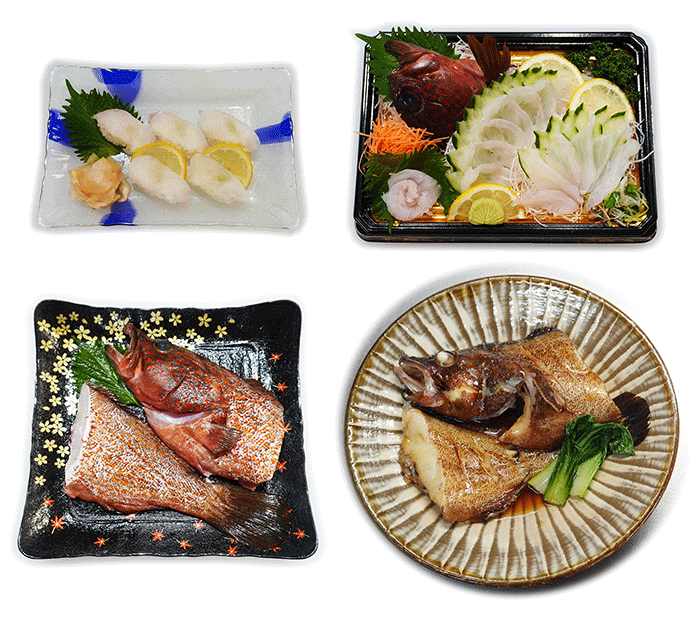
Commercialization of Red spotted grouper
Seven band grouper and longtooth grouper
At one store, a red spotted grouper with a size of about 600g was priced at 980 yen per fish. It was rigor mortis, but it was fresh enough to be used for sashimi and sushi, and I got it cheaply with other fish I chose together.

The red spotted grouper is a fish of the order Perciformes, Serranidae, and Epinephelus. This name is said to have been given because it resembles Japanese pheasant.

The same Epinephelus genus brother, Longtooth grouper, is also known as Ara in northern Kyushu such as Fukuoka, Nagasaki, and Saga, and the standard Japanese name Kue is in the cold season from October to February, which is contrary to this. The summer season from May to August is a completely different season from the seasonal red spotted grouper.
Seven band groupers and longtooth groupers belong to the same Epinephelus genus, and they are very similar and difficult to distinguish, and I think it's normal to not be able to immediately determine which one. Since there was an image that could be used as a reference for how to distinguish it, I will quote it as a reference material below.
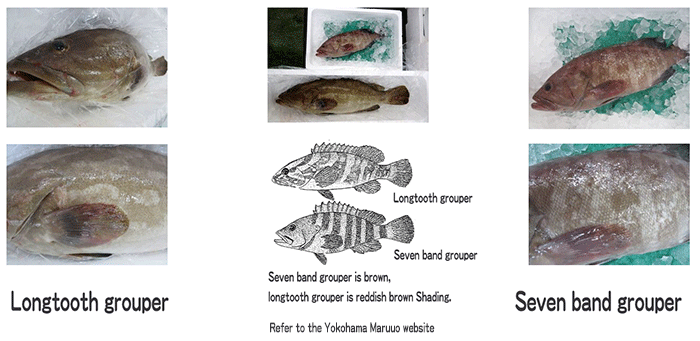
Expressed in words, "Long tooth grouper has two horizontal stripes flowing toward the head, while Seven band grouper has all horizontal stripes." Also, when the Longtooth grouper becomes an adult fish, these horizontal stripes almost disappear.
In the Kansai region, the red spotted grouper is called Akou, and it is called "winter puffer fish, summer Akou", and it has been prized to the extent that it is also called Puffer fish. However, the author had a red spotted grouper of 980 yen per fish discounted together with other fish, so the exact price is unknown, but I bought it even cheaper. It's Kyushu, not Kansai, and the evaluation of the red spotted grouper may be a little different, but at least I can say that the value of the red spotted grouper, which is originally a high-class fish, is not as high as it used to be.
This is really just an intuition without any backing. The reason I've come to feel that way these days is that the red spotted grouper is starting to stand out more than the reasonably priced yellow grouper that was often seen in the fish department as one of the high-end fish groupers. Since the price is based on the relationship between supply and demand, it seems that the COVID-19 pandemic has some influence on the cheap price, but even so, it has become cheaper these days.
The image below is a fish called Leopard coralgrouper, which looks exactly like a red spotted grouper, and is a fish of the Suzuki system Perciformes Suzuki suborder grouper Sujiara genus that lives a lot in Okinawa and the Nansei Islands.

The Leopard coral grouper is called Akajin-mibai in Okinawa and Hajin-nebari in Amami. In Okinawa, this fish is one of the three major high-class fish along with Akamachi (longtailed red snapper) and Makubu (Blackspot tuskfish). In these areas, the Leopard coral grouper has little sense of the season, which is limited to winter or summer, and can be used as the highest-ranked high-class fish all year round. And it is not uncommon for the selling price to be 5,000 yen per fish, and the price exceeding 10,000 yen is also normal.
In Kansai, the red spotted grouper should have been treated in the same way as the Leopard coral grouper in Okinawa before. However, recently red spotted groupers are often found in fish counters with a decent assortment level, and many of them are reasonably priced, and I feel that they are now being traded at fairly popular prices.
Protogynous
In fact, I've come to hear that not only red spotted groupers but also longtooth groupers, which should be rare among grouper family members, are being caught in relatively large numbers.
In Nagasaki, the Long tooth grouper is called Ara. The transaction price of ara should reach its peak from the time of the Kyushu sumo wrestling in November, but at the end of last year, I heard a voice from a fishery official saying, "Even if ara is caught, the price is too low, so it is a problem ...". Naturally, it seems that COVID-19 has a great influence on this price formation, but the environment for eating out has improved considerably from two years ago. Nevertheless, it seems that hearing such a voice is not limited to the influence of COVID-19, but there are other factors as well.
For example, it is possible that there may be changes in the environment in the sea. Since the author is a "skeptic of the theory of global warming," I have no intention of making up a false theory that one of the causes is global warming. However, for example, a fisherman said, "There is a fact that the bluefin tuna stock has been revived and expanded due to the catch regulation of the bluefin tuna, but the Japanese flying squid, which is the bait of the bluefin tuna, has decreased in reaction to that." I listen it seriously.
The basic stance of the author is "I don't understand at all" about the inside of the sea. Unfortunately, the author has little scientific knowledge about the causes of various events occurring in the sea. Therefore, when a fisherman tells me the fact that "a lot of Longtooth groupers are being caught these days," I think it must be a concrete fact that is happening in the field of fishing.
I'm a little worried about that. It is "Protogynous" which is one of the characteristics of the fish of the genus Epinephelus of the family Serranidae. In order to leave offspring in the fierce sea world, it is advantageous to have more children, so there are fish that perform "sex change" as a means to keep increasing the number of children. In fact, the grouper fish including the red spotted grouper is one of them, and the same is true for black sea bream, flathead, clownfish, and botan shrimp.
The genus Epinephelus lives in polygamy, and in polygamy, males compete fiercely over territory and females, so small males do not have territory and have difficulty in breeding. Therefore, when the body is small, it breeds with a large male as a female, and while avoiding losing in a territorial battle, it surely makes a fertilized egg containing its own gene. After that, when it grows up and exceeds 60 cm in length, it changes sex to a male.
Let's compare it with other grouper fish that have such a magical mechanism of prosperity of offspring. For example, bluefin tuna that have been targeted by humans to reduce their stocks and then increased their stocks due to fishing restrictions, and squids that have been preyed on by bluefin tuna and continue to lose their stocks. Compared to fish that are subject to drastic changes in stock conditions due to these external factors, grouper fish with Protogynous function can prosper their offspring with a very flexible mechanism.
Grouper fish are about two-thirds smaller than red sea bream and flatfish when hatched from eggs, but the number of eggs laid per fish is several million. In addition, grouper fish are not very good at swimming, and they stay in places with abundant food while acting alone without forming a flock on the rocky shore of the shallow sea, and prey on the creatures living in the reef area. Longtooth groupers and Seven band groupers grow to a total length of about 60 cm, but in rare cases, some individuals reach a total length of 2 m and 150 kg. It inhabits a wide range of temperate and tropical seas around the world, with 475 species in 64 genera recorded in the world, and 129 species in 30 genera in Japan alone.
In other words, it is speculated that grouper fish are growing in power in the sea with the magic of sex change called Protogynous as a weapon. For this reason, it seems that the weakening of power due to severe resource fluctuations such as bluefin tuna and squids will not occur in the future. The author speculates that the price of grouper fish will not rise due to the decrease in catch.
Commercialization of red spotted grouper
The red spotted grouper, which belongs to one of the great powers in the sea, is a high-class fish from the old days, but now it is easier to retail than before. Then, in June, which is the season for red spotted groupers, we have obtained a reasonably sized one at a reasonable price, so in this month's issue, we will introduce the commercialization that makes full use of one red spotted grouper.
When commercializing one red spotted grouper into sashimi, sushi, fillets, etc., the key to increasing added value is the method of two pieces disassembling. In order not to reduce the value of high-class fish such as red spotted grouper, it is recommended to fillet the fish with the head as shown in the image below.
| How to make a red spotted grouper into two pieces disassembling with a head | |
|---|---|
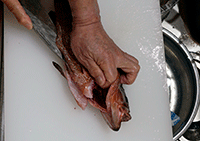 |
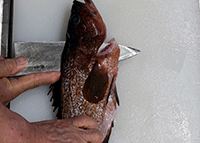 |
| 1,After removing the internal organs and wiping off the water, cut open on the anal fin of the lower body. | 5,Cut over the backbone from the tail to the head. |
 |
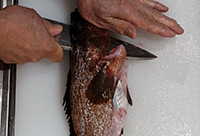 |
| 2,Make a notch on the tail side of the lower body dorsal fin. | 6,Firmly press the head with your left hand and cut the edge of the deba knife strongly into the center of the head. |
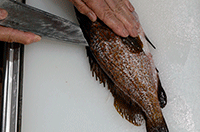 |
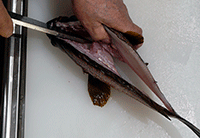 |
| 3,Cut over the central bone toward the head. | 7,In order to cut the stiff head in half, stand the fish and cut it further. |
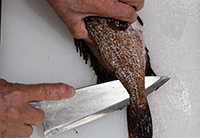 |
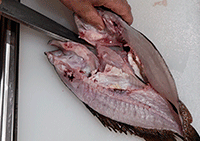 |
| 4,Cut the backbone of the tail part and make a hole. | 8,Finally, cut off the chin. |
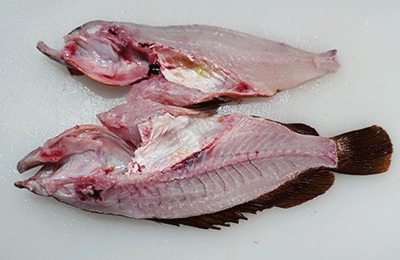 |
|
| Two pieces disassembling with a red spotted grouper head completed | |
After the two pieces disassembling of the red spotted grouper is finished, make a fillet product. Since the red spotted grouper is a high-class fish, select a container suitable for its value and commercialize it. Do not sell fillets in the form of 1/4, put out volume with a half body with a head, appeal value rather than cheapness, and give a bullish selling price.
| red spotted grouper fillet commercialization | |
|---|---|
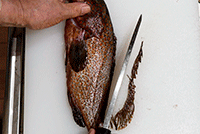 |
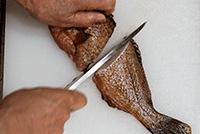 |
| 1,Cut off the dorsal fin. | 3,Divide in half with the head attached. |
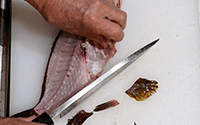 |
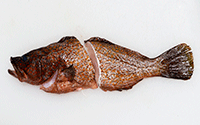 |
| 2,Cut off pectoral fin, pelvic fin, and anal fin. | 4,Half-split red spotted grouper |
 |
|
| Half-body fillet of red spotted grouper | |
| red spotted grouper fillet boiled fish work process | |
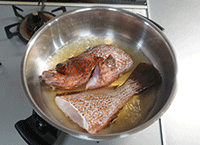 |
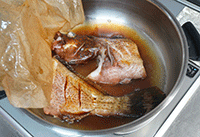 |
| 1,Put the fillet in boiling broth. | 3,Occasionally turn over the otoshi buta and sprinkle the broth on top of the fish. To finish, add 1 tablespoon of mirin and simmer again to bring out the shine. |
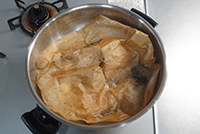 |
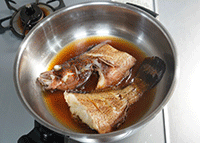 |
| 2,Put on the otoshi buta. | 4,Turn off the heat and leave it for a while to let cool slightly after cooking |
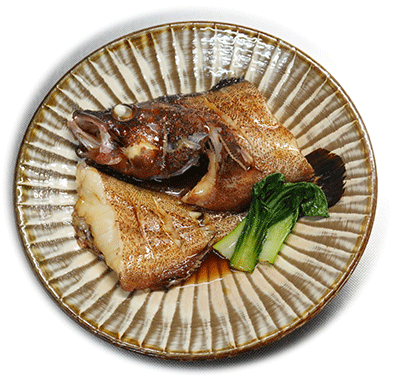 |
|
| Red spotted grouper boiled fish | |
Next, the remaining half of the body is used to commercialize sashimi and sushi.
| Red spotted grouper sashimi and sushi | |
|---|---|
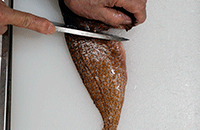 |
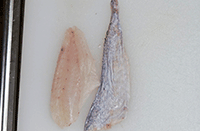 |
| 1,Cut off the lower body with the head as a cross. At this time, the head is used for sashimi decoration, so do not throw it away. | 4,With the skin removed. |
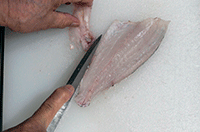 |
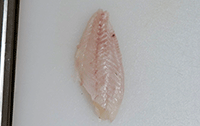 |
| 2,Remove the belly bone of the lower body that dropped the head. | 5,The bottom of the skin is smooth and smooth, and there is a moderate amount of fat on it. |
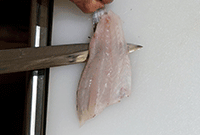 |
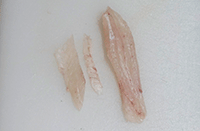 |
| 3,Remove the skin by the method of sotobiki. | 6,Separate the lower body into a back body and a belly body. |
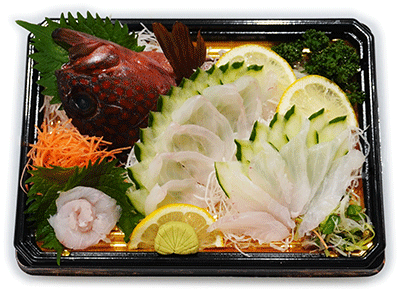 |
|
| Red spotted grouper figure-making style usutsukuri sashimi | |
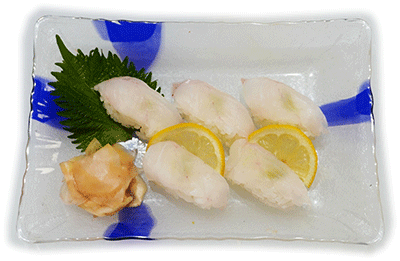 |
|
| Nigiri sushi with red spotted grouper's belly body | |
Survival and growth
FISH FOOD TIMES has introduced some grouper fish so far. June 2007 issue Seven band groupe usutsukuri sashimi, December 2012 issue Ara-chanko nabe, May 2016 issue Red-spotted rockcod grilled sashimi, September 2016 issue Yellow grouper usutsukuri sashimi, etc. ..
I have reread these past articles myself and now feel that there are various problems in terms of content. However, I decided to give up because I didn't have the power of the author at that time. If you have the time, I'd like you to take a look at these as well, but maybe you'll find some useful information with different knowledge from this month's issue.
Actually, Blacktip grouper, which is very close to Red spotted grouper, is also stocked as an image and I would like to introduce it at another time, but I am wondering how it can be expressed from a different perspective with this month's issue of Red spotted grouper.

In this way, including the past, when I researched and mentioned various grouper fish such as Seven band grouper, Longtooth grouper, Leopard coral grouper, yellow grouper, red spotted grouper, Blacktip grouper, etc., these are temperate to tropical seas around the world. You can see that it lives widely in the area. And it can be understood that it is one of the major powers among the fish with 64 genera and 475 species in the world and 30 genera and 129 species in Japan alone.
Many of the grouper fish in the seas around the world are white flesh and have no peculiarity and are delicious, and it seems that they are treated as high-class fish not only in Japan but also in foreign countries. Therefore, it may be shot as a fish that can be easily converted into money in the future. And as a result, will we face a situation of resource depletion that is subject to fishing restrictions? I'm guessing that's probably not the case.
This is because not only the magical function of Protogynous, but also the fact that tens of thousands of fish do not act in groups like blue-backed fish such as sardines and mackerels. the grouper fish is because they are basically acting alone, so they are not caught in large quantities at one time. The sardines that form a large herd have been called phantom fish due to their reduced resources, and in the past they have repeatedly risen and fallen. However, when the grouper fish is small, it receives the protection of a male as a female, and when it can grow to a giant body of 60 kg, it changes sex to a male and follows the female in a single action to prosper the offspring, so this method is better. Is convenient for surviving in the competition for survival in the sea.
This may be a theory that can be applied to the business of human society. For example, if a person can continue to live in a privileged situation in a large organization, gain experience, accumulate knowledge, and grow significantly as a person, then jump out of that organization and their abilities rather than the established reputation of the company. I think that it is the same as being able to walk across society.
I think it must be great to be the top of the organization as a businessman. However, rather than settling in a blessed situation and living mediocrely and reaching retirement age, I will start swimming in the rough seas where I do not know what will happen in the future, and I will drown on the way, or I will swim to the island of paradise and become a king, I think that trying to reign is one of the options in life.
America, which leads the world's business, has a strong entrepreneurial spirit, and I think there is an environment where new businesses can be easily created one after another. How about Japan, where the economic decline is remarkable compared to that? What I find problematic in Japan is that the country is too tightly bound, especially in the food industry. In Japan, the law says, "That's no good, this is no good, no good, no ..., regulation, regulation, regulation ...". The government is saying that it is for the safety and security of the people, but if the government offices continue to be bound by law, I think that entrepreneurs will not appear in Japan in the future.
I don't think readers are (probably) transsexual like the grouper fish because they are humans. However, you should be able to improve your ability as a businessman, grow as a human being, and transform you significantly.
Let's say it at the end. You who are independent in the fishery industry and are working hard in a lonely struggle ... By all means, I want you to grow up like a longtooth grouper that weighs as much as 150 kg. I will spare no effort to support you from the bottom of my heart ...
| Please access the following URL if you want to secure using SSL. All pages in the site will be secure pages. |
https://secure02.blue.shared-server.net/www.fish-food.co.jp/message english 6.2022.html |
An opinion and the communication are to iinfo@fish food times
Date of updating 1 Jun. 2022
